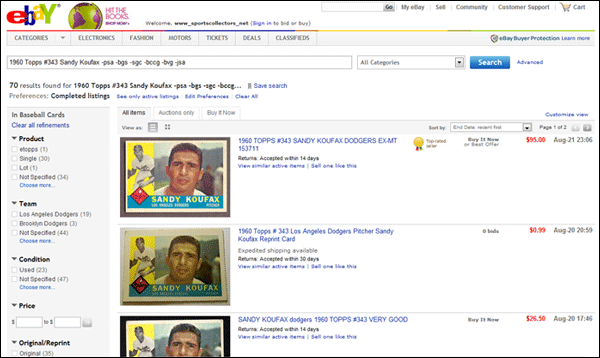Is Searching eBay a reliable way to determine Market Value?

Disclaimer: I am a huge fan of eBay and the significant disruption they brought about for buyers and sellers. I have been a frequent buyer and occasional seller on the site since 1998 and continue to use it every day. Nothing in this post is meant to put eBay (the company or marketplace) in a negative light.
I have seen a good many people base their selling and purchasing decisions solely on data they can find from the closed listings from the past 60 days for a particular search on eBay. I have heard them refer to this as "Market Value". While I think this is extremely valuable and easily accessible information, I am not sure it is a complete and accurate picture for market value.
Background Info and Definitions
First, let's establish definitions for some common terminology:
Market is the opportunity to buy or sell, extent of demand for merchandise. More simply, a market represents the total population of available offerings for a given commodity (product/service) or security.
Marketplace is a location where goods and services are exchanged.
Market Value (also known as Fair Market Value) refers to the price that a seller of commodity (product/service) or security can expect to receive from a buyer in a fair and open negotiation.
Standard Deviation if the statistical measure for how much variation or "dispersion" exists from the average (mean, or expected value). A low standard deviation indicates that the data points tend to be very close to the mean, whereas high standard deviation indicates that the data points are spread out over a large range of values. In addition to expressing the variability of a population, standard deviation is commonly used to measure confidence in statistical conclusions.
Confidence is used to indicate the reliability of an estimate. It is an observed interval (i.e. it is calculated from the observations), in principle different from sample to sample, that frequently includes the parameter of interest, if the experiment is repeated.
Searching for current items available and completed listings on eBay
eBay is a marketplace for buying and selling various items. In fact, their tagline was once "the world's largest marketplace".
To best illustrate how to search ebay I will use an example, gathering information on a commodity item - an ungraded 1960 Topps Sandy Koufax baseball card.
On ebay.com, we can search for the keyowrds:
1960 Topps #343 Sandy Koufax -psa -bgs -sgc -bccg -bvg -jsa -reprint -rp
The search would currently return 46 total results. 10 are in auction format (1 with the buy now option) and 36 in fixed price format. The average price right now is $79.87, but we should expect that average price to rise for this set of listings as the auctions will likely receive more bids.
If you are new to eBay, you may be interested to know that it is easy for any registered user to view the results of recently ended listings. No doubt that this is fantastic information and should definitely be considered, and many of us are grateful they make it freely available to us now (I believe they charged for historical sales data at one point through a partner).
The search results for completed listings of that same search term (pictured below) show there were 70 total items:
 |
Out of those 70 completed listings, 60 show they resulted in successful sales ranging between $1.36 and $124.50 for an average of $39.09.
48 of those 60 sales were auction format for an average of $35.71.
Of the 10 items that did not sell, 7 were fixed price format and 3 were auction format with an average asking price of $61.50.
When we look the data from only the past 2 weeks, we see that 22 closed but only12 resulted in a sales. This is because the results screen will only display listings that did not sell from the past 14 days. Most people probably don't realize this, and can easily make false assumptions about demand and various other market dynamics.
In looking at the data from both searches, it is interesting to note that the majority of listings are fixed price (78%), but fixed price ones represent only 20% of the items that result in sales. This means that while the auction format is not the primary method for offering this product, it most often results in sales (although at a lower price point).
Is eBay representative of the market?
eBay is a single (very large) marketplace, but it does not constitute the entire market for selling commodity items. There are other individual sellers and marketplaces offering the same commodity goods that maybe we should consider.
If I do searches on Google and Bing, I can find over 150 copies of the same ungraded 1960 Topps Sandy Koufax card for sale on sites other than eBay. Every one of them is being offered in a fixed price format and they have a 15% higher average price than we saw from the closed listings on eBay.
Determinants of Market Value
What about other factors relevant in determining Market Value that can not be easily evaluated by a few searches? Here are a few to consider:
- Demand - In the last post, we recognized the important relationship between pricing and demand. Are these 2 searches a good indication of demand for the product? Is there other information on eBay we can use to assess demand?
- Time - Since demand is relative to time and location, we should probably factor in the timing of the sales. Is the sale happening at an off hour or slower day of the week, and how should this information be considered?
- Seller - Do items offered by certain sellers consistently sell more often and for more money than others (due to marketing, customer service, reputation, location, etc.)?
- Price Elasticity of Demand - Do the sale figures in the completed listings tell us anything valuable about the item's elasticity? If so, how would we consider this in determining market value?
- Selling format - How does the selling format value impact value guidance? Should we consider items sold in fixed priced, auction, reverse auction formats differently.
- Location - How does the physical location (state or country of seller) or relative location (the site the product is advertised) influence price?
- Consumers - Is there something unique to the consumers on eBay that is different than the rest of the market?
- Weighting factors - Should all factors be evaluated evenly, or should be weighted more heavily? If weighting is uneven, how to determine the weighting?
Differences between the findings from the eBay searches and the rest of the market
Since we know eBay is not the entire market, we must ask ourselves if the sample we are seeing from eBay representative of the entire market data we see for this product? In our example (the 1960 Topps Sandy Koufax card), we saw the following differences between eBay and the overall market:
- eBay sales were made up of fixed price and auction formats, while the rest of the market was fixed price format.
- eBay sales figures had a higher standard deviation of sales figures than the rest of the market.
- eBay likely has greater inventory of many products than other sites, providing a better opportunity for competitive shopping in a single marketplace. Items from other stores/marketplaces likely will not have the exposure, competitive bidding, and variance due to limited choices.
- Assessing completed sales values may not be readily (freely) available as they are from eBay.
Conclusions
I believe eBay by itself can be an effective indicator for market value. How much will depend greatly on the particular product, its market, and its determinants. While a good indicator is certainly nice to have as a reference, I am not sure I would be comfortable basing purchasing decisions completely off of it. Here's why:
- I went through the exercise of measuring the effect of the above mentioned determinants along with quite a few sports card specific ones. After quite a bit of processing, I came up with an algorithm that has led me to effectively make informed purchasing decisions - leading to discounted purchases. These determinants may be as important as price - depending on the particular product and market.
- The fact that most items offered in the market are via fixed price and most sales on eBay take place via auction tells us that eBay may not be representative of the market.
Selling format, in particular, is a key determinant. We may consider excluding or lowering the weight for the auction items from the closed listings, as this selling format likely has a large effect on buyer interest and sale price (especially auctions with low starting bids). If we look only at the fixed price closed listings in our example, we see the average price rise and move closer to that of other sites. By doing this, we reduce our sample size by 80% (from 60 to 12). We'll see that the fixed price closed listings are more similar, meaning they have a smaller standard deviation and would allow us to be more confident with our value estimate.
- Seeing a normalized distribution for sales is very desirable state when assessing a product's value. It implies that there aren't many statistical outliers being considered, which would skew the results. Since we saw a higher standard deviation, it means that eBay sales experience greater volatility (likely due to the auction format) and inspires lower confidence in the overall number.
If we deem the factors such as demand, selling format, time, seller, etc. as statistically relevant to assessing the market value (which I would), it seems like it would be a challenge to properly consider these weighted factors easily by doing a few searches manually.
Volatility is often sought by buyers, as it can lead to find exceptional buying opportunities. We will discuss arbitrage scenarios in a future post where buyers can exploit such volatility for profit.
- The example we saw on the Koufax card was actually pretty close to the market value that I independently calculated suggests for this card of $40.85 (on SportsCardDatabase) - the eBay average was about 12% lower. If you are a retailer and you consistently sell for 12% below the optimal value, your business is missing out on opportunity.
eBay sales averages for commodity baseball cards from the 1960's are more often fall 18%-20% below the optimal market values. I have noticed other categories of commodity products consistently selling for 50% below market value and others selling 50% above market value.
